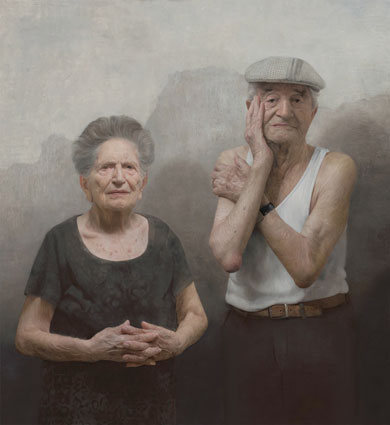 "Louise and Lazar Farkas" by David KassanArtist David Kassan will be in residence at the University of Alabama at Birmingham from Nov. 12-16, when he will make a portrait of a Holocaust survivor, work with students and give a lecture.
"Louise and Lazar Farkas" by David KassanArtist David Kassan will be in residence at the University of Alabama at Birmingham from Nov. 12-16, when he will make a portrait of a Holocaust survivor, work with students and give a lecture.
Kassan’s visit is part of the biennial print atelier program of the College of Arts and Sciences’ Department of Art and Art History, which has partnered with the Birmingham Holocaust Education Center and Temple Beth-El for programming.
Kassan will work on the print through the week and give a lecture at Temple Beth-El at 6:30 p.m. Thursday, Nov. 15. His lecture will focus on the “EDUT” project and his work while artist-in-residence. A coffee and dessert reception will follow.
The lecture will also coincide with remembrance of the 80th anniversary of Kristallnacht, when Nazis in Germany torched synagogues, vandalized Jewish homes, schools and businesses, and killed close to 100 Jewish people.
The lecture is funded in support by the UAB DAAH, the Jemison Visiting Professorship in the Humanities, BHEC and Temple Beth-El.
The Birmingham Holocaust Education Center seeks to educate the people of Alabama about the history of the Holocaust so that new generations will apply the lessons of the Holocaust to the construction of a more just, humane and tolerant future. Organized in 2002, the BHEC provides programming throughout the state of Alabama for teachers, students, civic groups and communities.
Since 2009, Associate Professor of Printmaking Derek Cracco has led the visiting artist atelier program, connecting artists to UAB art students in the joint production of unique works of art. The program promotes historical and contemporary printmaking practices and introduces printmaking methods to artists whose works typically lie outside the medium. As part of the residency, Cracco offers intensive, one-on-one training to connect each artist’s research interests and aesthetics with his or her envisioned print concepts, and invites printmaking students to work with the visiting artist.
| In 2014, Kassan began painting and documenting survivors of the Holocaust, with the development of the “EDUT” project — “edut” being Hebrew for “living witnesses” — as a way of connecting with his grandfather’s traumatic history escaping ethnic cleansing on the Romania/Ukraine border to come to America in 1917. |
The projects are executed within the historic tradition of the artist’s atelier, French for workshop or studio, where young artists and artisans learn techniques and execute works under a master.
“This series gives UAB students the opportunity to work alongside established artists by assisting in a project,” Cracco said. “As studio technicians, the students use their knowledge and skills, including relief, intaglio and planographic methods, to help each artist achieve his or her goals. Through these projects, the students are also challenged to creatively solve problems they may not usually face in their personal studio practices.
“It is always interesting to see how each visiting artist embraces the medium while approaching the processes of printmaking from different directions,” Cracco said. Money raised from the sale of prints also will support the UAB DAAH Visiting Artist and Scholar Series.
Kassan, born 1977 in Little Rock, Arkansas, is an internationally recognized contemporary American painter best known for his life-size representational paintings, which combine figurative subjects with symbolic textured abstract backgrounds. Kassan’s work is best classified as social documentary painting due to the importance and relevance of the subjects he chooses to represent.
In 2014, Kassan began painting and documenting survivors of the Holocaust, with the development of the “EDUT” project — “edut” being Hebrew for “living witnesses” — as a way of connecting with his grandfather’s traumatic history escaping ethnic cleansing on the Romania/Ukraine border to come to America in 1917. The “EDUT” project’s mission is to meet with as many living survivors of the Shoah as possible and to document them in filmed video portraits and in paintings and drawings.
While many survivors have already told their stories on video or in memoirs, Kassan believes painting offers viewers a different kind of connection to the survivors.
Temple Beth-El is honored to be a part of programming aimed at celebrating Holocaust survivors, and teaching about the suffering of Jews and non-Jews during a difficult period in history. Founded in 1907, Beth-El’s congregation is committed to meaningful and relevant lifelong learning, joyful worship, and fulfillment of mitzvot with a special focus on tikkun olam, the healing of the world.
